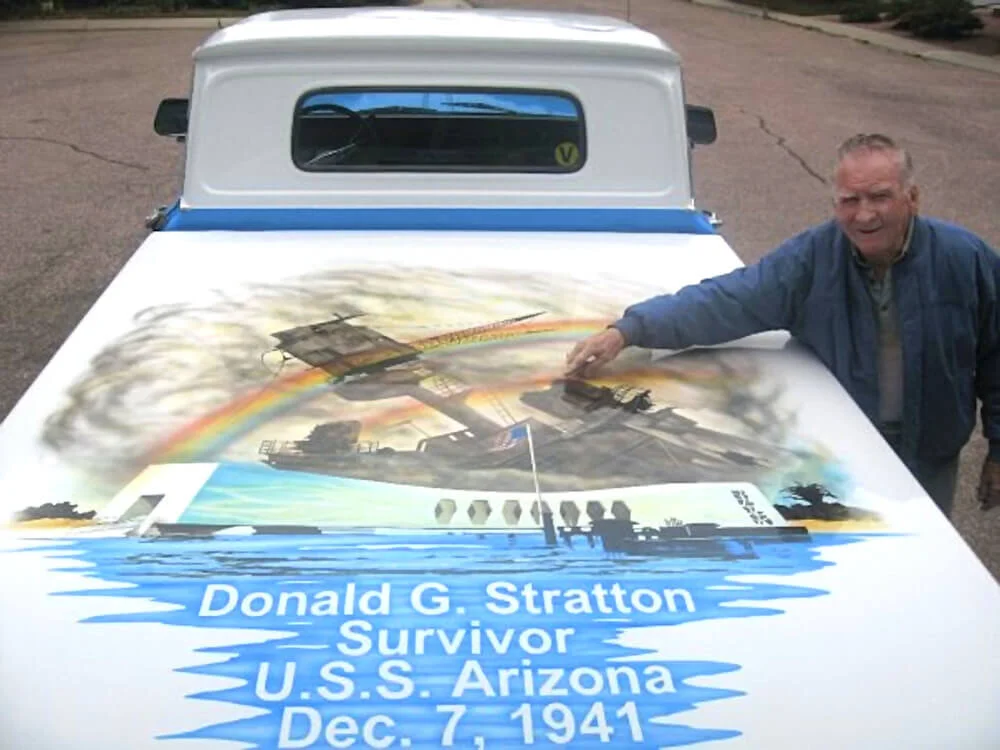Perhaps the most emotional experience I’ve had in the cinema was watching a movie that’s not on anyone’s Oscars list this year. ‘Midway’ brought to life the experiences of war veterans I interviewed while making ‘Seconds from Disaster’ for National Geographic back in February 2011. I travelled 25,000 miles to listen to the stories of Takeo Shiro, Don Stratton and Mal Middlesworth. The journey changed my understanding of war.
The first stop on my journey was Colorado Springs, to speak to Don Stratton. Today, he is one of only three survivors still alive from the USS Arizona. I have vivid memories of sitting in Don’s living room as he described climbing a rope to escape the burning battleship. He kept losing grip because the skin was peeling off his hands. The scene was reproduced pretty faithfully in the movie, but obviously they don’t show the really gruesome stuff. By the time Don received medical attention, burns covered 65 percent of his body. He was 19 years old.
The USS Arizona exploded when a bomb detonated its forward ammunition stores. 1,177 men died.
I've interviewed a lot of war veterans over the years, and I never met anyone else who handled trauma like Don. Even though he’d told the story a hundred times, it was obvious during the interview that the memories were still painful, but he didn’t run away from them. I guess his way of coping was to embrace them, and accept them as the formative experience they must have been.
Don’s pride and joy - a 1965 Chevy truck, painted with a full colour scene of the Arizona.
From Colorado it was a short hop to Los Angeles to meet Mal Middlesworth. At the time of Pearl Harbor, Mal was a Marine serving on the heavy cruiser USS San Francsico. He was a cooler customer than Don. His ship hadn’t come under direct attack (The Japanese bombers concentrated on the larger battleships), so he was more of a first-hand witness to events than a direct participant. Even so, you could tell the experience had left its mark on him. He was a natural storyteller, and after the war, he became a film-maker, so he was a great interviewee. He welcomed me and my crew into his home, and made the whole day we spent with him light and fun. I'm 6'5" and by coincidence, both my cameraman and sound-recordist that day were pretty much as tall, so he called us 'The Basketball Team'.
The next stop was Pearl Harbor itself. I didn’t do interviews here. (One with the base’s current commander didn’t make the cut in the final film). The main goal was to shoot background plates of the real locations where the attack happened, so our graphics team could recreate it with CGI. It was possible only because most of the island’s infrastructure from 1941 has been left intact - control towers, hangars, offices, accomodation - it’s all still there. It’s a curious irony - the bombing of Pearl Harbor has effectively preserved it, by turning the whole site into a national historical monument. The period officers’ accomodation is particularly spectacular.
Apparently, the historic housing makes Pearl Harbor a popular posting for Navy wives.
From Hawaii, I flew to Japan to interview naval aviators who’d taken part in the attack (and a Japanese professor). I was surprised to discover that there are loads of flights covering this route, because Hawaii has become a massively popular tourist destination for the Japanese. I don’t quite get it, because Oahu didn’t particularly impress me as an island paradise, and they have Bali/Thailand etc in relatively easy reach, but it’s another curious irony of history.
Interviewing the Japanese naval aviators turned out to be a fascinating and fraught process. I drove my interpreter mad because I'd never worked in Japan before, and I hadn't brought business cards. The veterans are high status guys, and their families had to be convinced to permit the interview.
Takeo Shiro, in uniform as a torpedo bomber pilot
So before I could talk to Takeo Shiro, I had to be interviewed by his family so they could establish my worthiness to have an audience with the venerable elder. I faced a battery of questions about my age, heritage and wealth. This would obviously not be OK in the US and Europe, but as a film-maker, and a guest in their homes, you have to play by their rules.
I was 34, but I looked younger, (ha ha) which made life difficult. Basically my ass was saved by my interpreter, the fantastic Mai Nishiyama. I don’t know what I expected from Takeo, but it was striking how clearly he perceived his younger self. He remembered being that person, full of dreams of winning glory for Japan, but he’d grown up, and he could see those dreams for what they were. His entire generation had been brainwashed into thinking their lives had value only in service to the Emperor.
His account of the attack on Pearl Harbor was more technical and detached than the others. In a way, that’s not surprising - he was flying above all the chaos, but it is something I often find with aviators - they are calm and clinical, skilled operators of the machinery of death. After conducting his torpedo run, Takeo circled over the harbor to take this picture.
Battleship Row, Pearl Harbor. If you look closely, you can see the trails of other torpedoes in the water
In the end, my film didn't quite have the production values of a Hollywood feature, but I'm still proud of the work we did. For CGI that’s now 9 years old, our Japanese bombers hold up pretty well.





